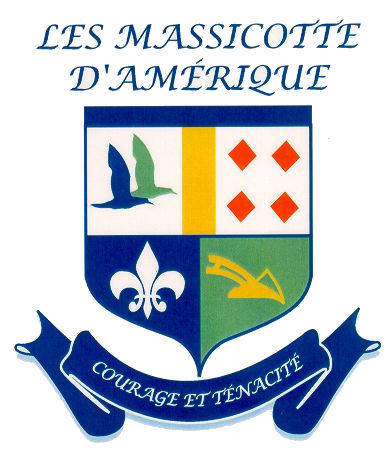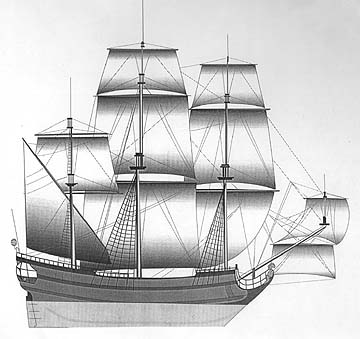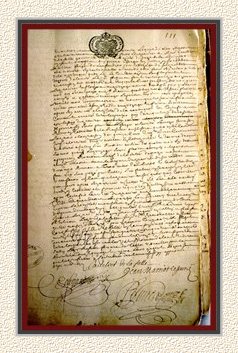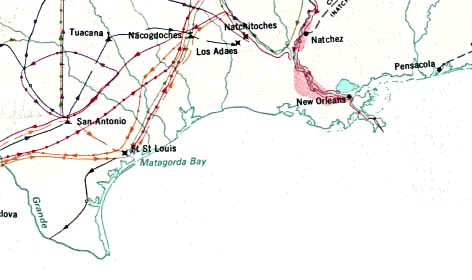
Jean Massicot (Jacques cousin?)
 La Salle |
On
the 24th of July 1684, after 17th-century French explorer Renee  Robert
Cavelier, Sieur de La Salle had completed the inventory of all the things
needed for his journey, and had overcome all the obstacles with several
persons who were opposed to it, they set out from the homestead of Chefdebois
at La Rochelle, France numbering four vessels, one of which was a man-of-war
called the Joly of thirty-six to forty guns, commanded by M. de Beaujeu;
the others, a small frigate or barque called the Belle of about sixty tons'
burden, armed with six guns, commanded by two masters (it had been given
to La Salle by the King); a store-ship of about three hundred tons' burden,
called the Aimable, belonging to a merchant of La Rochelle called
Massicot, commanded by one Aygron,- she carried the greater part of
the goods and the number of men who were bound for the mouth of the Mississippi
River, where La Salle hoped to establish a French colony. This information
is from the Glenn
Black Laboratory of Archaelogy, Indiana University.
Robert
Cavelier, Sieur de La Salle had completed the inventory of all the things
needed for his journey, and had overcome all the obstacles with several
persons who were opposed to it, they set out from the homestead of Chefdebois
at La Rochelle, France numbering four vessels, one of which was a man-of-war
called the Joly of thirty-six to forty guns, commanded by M. de Beaujeu;
the others, a small frigate or barque called the Belle of about sixty tons'
burden, armed with six guns, commanded by two masters (it had been given
to La Salle by the King); a store-ship of about three hundred tons' burden,
called the Aimable, belonging to a merchant of La Rochelle called
Massicot, commanded by one Aygron,- she carried the greater part of
the goods and the number of men who were bound for the mouth of the Mississippi
River, where La Salle hoped to establish a French colony. This information
is from the Glenn
Black Laboratory of Archaelogy, Indiana University.
Shown on the right is the leasing contract between Cavelier de La Salle and Jean Massicot (the young person) of the ship Aimable. It is verified with Center for Historical Archaelogy. The photo is copyright by John de Bry.
My understanding is when they say (the young person) they're talking about the son of the father with the same name. In this case Jean's father would be Jean as well. So, Jean is most likely Jacques cousin of around the same age of about 23 years old.
The Texas Historical Commission confirmed in August of 1998 that the historic shipwreck discovered February of 1998 in the Gulf of Mexico by the National Underwater and Marine Agency is NOT the Aimable, a 180-ton storeship that was part of French explorer Rene Robert Cavelier, Sieur de La Salle's 17th century expedition to the New World. Archaeologists believe that the shipwreck dates to the mid- to late 18th century and may be of Spanish origin. Originally it was thought to be that of the Aimable, one of four ships brought to the New World by famed 17th-century French explorer Renee Robert Cavelier, Sieur de La Salle. La Salle left France in 1684 to establish a colony at the mouth of the Mississippi River but overshot his mark and landed along the Texas Coast. The Aimable ran aground on a sandbar as it entered the bay and broke into pieces before it sank in 1685. La Salle used timbers from the Aimable to build a fort, called Fort St. Louis (after King Louis the XIV). The fort is located on the Mategorda Bay of Texas as shown below. But it is no longer there.

Last
Updated
May 19th, 2002